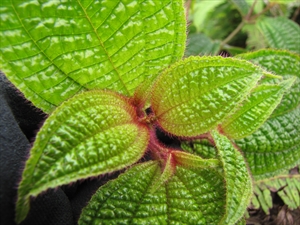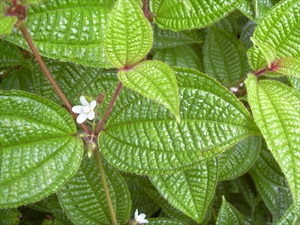Koster's curse; it is also known as soapbush.
Pacific Pests, Pathogens and Weeds - Online edition
Pacific Pests, Pathogens & Weeds
Koster's curse (448)
Clidemia hirta. It was known previously as Clidemia elegans, Melastoma elegans. It is a member of the Melastomataceae.
Asia, East Africa, South and Southeast Asia, North, South and Central America, the Caribbean, Oceania. It is recorded from Australia, American Samoa, Fiji, Guam, Palau, Papua New Guinea, Samoa, Solomon Islands, Tonga, Vanuatu, and Wallis & Futuna.
Koster's curse is native to much of tropical America.
An extremely important invasive weed, and especially a threat to Pacific islands. Koster's curse forms dense thickets that smother plantations, pastures and native vegetation, but it is also found in open grasslands, roadsides, open woodlands, banks of streams and rivers, forest margins and rainforests (Photo 1). The weed invades both disturbed and undisturbed areas, but it is especially problematic after storms, feral pig damage, landslides and fire. Its success as a weed is due to high seed production, rapid growth, wide range of environmental tolerance - drought, full sun and shade, rainfall between 1000 and 4000 mm, up to 1500 masl - and ease of spread.
A perennial shrub, usually less than 1 m tall, although much taller under shade. Young stems rounded, covered in large, stiff, brown or reddish hairs. Leaves, 5-18 cm long and 3-8 cm wide, dark green, in opposite pairs, on short stalks, 5-30 mm, oval with broad base and pointed tips, wrinkled, with five distinct veins parallel to the length of the leaf, and prominent cross-veins (Photo 2). Upper surfaces sparsely covered in hairs, more dense below and at the margins. Flowers in small clusters in leaf forks or at the tips of branches, each on a very short stalk, 0.5-1 mm, with five white or pink petals, 6-10 mm long and 4-5 mm wide (Photos 3-6). The base of the flower is swollen and covered with bristles and hairs (Photo 4). Male parts (stamens) are claw-like (Photo 6). The fruits are round, purplish-black berries containing more than 100 brown seeds (Photos 5&6). Seeds remain viable in soil for up to 4 years.
Spread is by seed, dispersed mainly by fruit-eating birds on other animals (e.g., feral pigs), on clothing, and in floodwaters. Long distance spread in soil on vehicles, and use of the plant as an ornamental.
Koster's curse is a significant invasive weed. Its main impact is the damage it causes to the environment and to biodiversity. It grows rapidly, competing with native species in gaps in undisturbed forests and has the potential to alter forest regeneration. In this way, it has damaged mountain rainforests in Samoa, Fiji and Hawaii, and is an invasive weed and threat to native forests in the Comoro Islands, Réunion, Seychelles, Mauritius and Madagascar. In Fiji, economic impact was considerable before it was brought under control biologically: it covered thousands of hectares of pastures and coconut plantations.
The fruit is edible, but said to lack flavour; the weed is used to treat skin infections in Brazil. It's a pioneer species and rapidly invades disturbed areas restoring native woodlands within its native area; outside its native range it displaces native species.
BIOSECURITY
There is a high risk of introduction of this weed. Once established, Koster's curse is extremely difficult to control. A large amount of seed is produced, and this stays viable in the ground for some years. Countries not yet infested by Koster's curse should consider all likely pathways for entry, and apply quarantine measures accordingly. It is a restricted invasive plant under biosecurity acts in some parts of Australia; this means - a person must not release these invasive plants into the environment, give away or sell as a plant or something infested with its seeds.
Clidemia hirta is among 100 of the World's Worst Invasive Alien Species compiled by the Global Invasive Species Database, maintained by the IUCN Invasive Species Specialist Group, 2020
BIOLOGICAL CONTROL
The thrips Liothrips urichi from Trinidad was released into Fiji in 1931, and taken from there and released in Hawaii in 1953. The thrips lives in the shoots tips, and heavy attack leads to dieback and, importantly, loss of seed production. In Fiji, it has been a success, attacking young shoots and leaves of Koster's curse, so that competing weeds, such as Mikania micrantha, Mimosa pudica and Brachaiara mutica, grow over and smother it. These competing weeds were controlled by cattle. In Fiji, but not Hawaii, the thrips provided control in shaded forests. Only in wet areas under shade or where density of cattle was high, was control unsatisfactory. More recently, Lius peisodon, a beetle, has been released into Hawaii and attacks Koster's curse in the shade. The fungus, Colletotrichum gloeosporiode f.sp. clidemiae, was introduced in 1986, and appears to be attacking Koster's curse in drier parts of Hawaii in both shaded and unshaped areas.
CULTURAL CONTROL
It is important to monitor remote Koster's curse-free areas - parks, reserves, wilderness areas, to control this weed before seeding occurs, as control is very difficult once a seedbank has been established.
- Physical & Mechanical
- Pull-out seedlings by hand, including the roots.
- Plough arable land, and cultivate by traditional methods.
- Dig out or use a pick in rocky ground, and destroy by burning. Note, that in wet areas the uprooted plants may regrow.
Note, that in all these situations it is important to monitor and follow-up with chemical control if necessary.
- Manage feral pigs
-
Control feral pigs which disturb ground and allow colonisation by Koster's curse.
-
- Hygiene
- Treat vehicles and farm machinery. If moving from areas where the weed occurs to those weed-free, wash to remove soil. This is equally important if the machinery is being imported into a country or moved within a country. Also, ensure seeds are not carried on clothes between infested and 'clean' areas.
CHEMICAL CONTROL
In Australia: glyphosate (and Fiji); metsulfuron-methyl; fluroxypyr, are registered (or under permit) for use against Koster's curse.
--------------------
Note, EU approval to use glyphosate ends in December 2022; its use after that date is under discussion.
____________________
When using a pesticide, always wear protective clothing and follow the instructions on the product label, such as dosage, timing of application, and pre-harvest interval. Recommendations will vary with the crop and system of cultivation. Expert advice on the most appropriate herbicides to use should always be sought from local agricultural authorities.
AUTHORS Grahame Jackson & Aradhana Deesh
Information from Clidemia hirta (L.) D. Don (2016) Weeds of Australia. Biosecurity Queensland edition. Queensland Government. (https://keyserver.lucidcentral.org/weeds/data/media/Html/clidemia_hirta.htm); and CABI (2019) Clidemia hirta (Koster's curse). Invasive Species Compendium. (https://www.cabi.org/isc/datasheet/13934); and Clidemia hirta (2019) Wikipedia. (https://en.wikipedia.org/wiki/Clidemia_hirta); and Koster's curse (Clidemia hirta) (2018) NSW Weedside. Department of Primary Industries. (https://weeds.dpi.nsw.gov.au/Weeds/Kosterscurse); and Clidemia hirta (2013) Bugwood wiki. (https://wiki.bugwood.org/Clidemia_hirta); and Waterhouse & DF, Norris KR (1987) Clidemia hirta (Linnaeus) D. Don Biological Control Pacific Prospects. Inkata Press, Melbourne. Photos 1-6 Forest & Kim Starr. Starr Environmental, Flickr; and from CHAH (2011) Clidemia hirta (L.) D.Don. WeedsAustralia - Profiles. Department of Sustainability, Environment, Water, Population and Communitie. (https://profiles.ala.org.au/opus/weeds-australia/profile/Clidemia%20hirta).
Produced with support from the Australian Centre for International Agricultural Research under project HORT/2016/185: Responding to emerging pest and disease threats to horticulture in the Pacific islands, implemented by the University of Queensland, in association with the Pacific Community and Koronivia Research Station, Ministry of Agriculture, Fiji.










